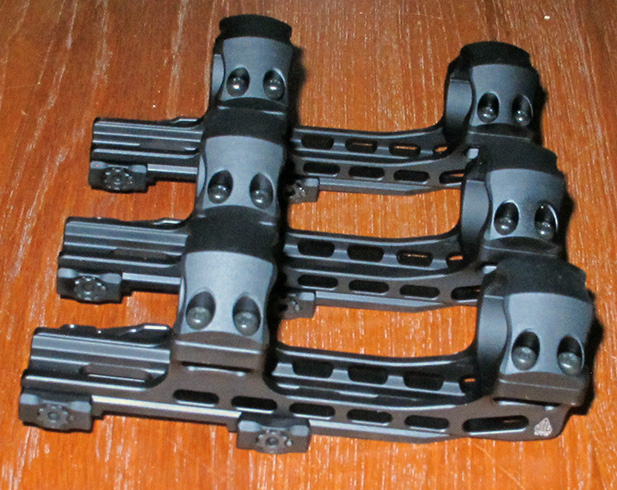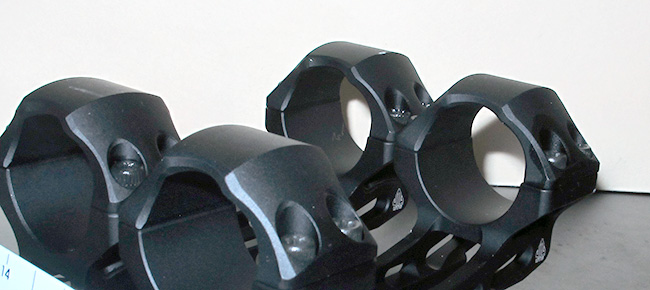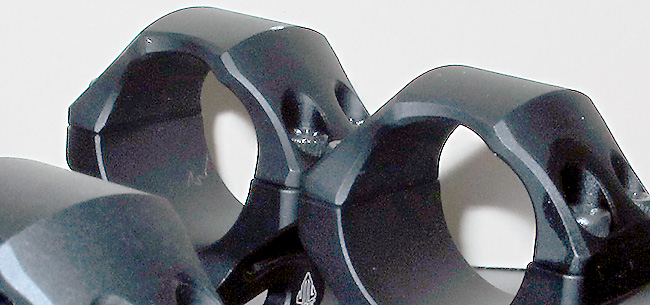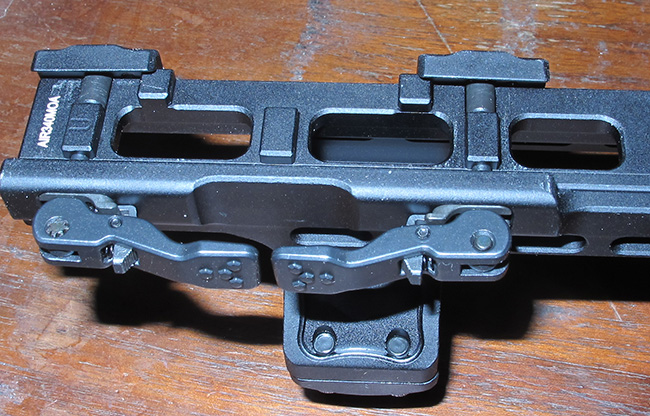
Three UTG drooper scope mounts—20 in front, then 30 MOA and 40 MOA.
This report covers:
- Drooping barrel?
- Problem firearm
- The UTG solution
- Hard to see
- How should I test?
- Description
- Final word
Today we begin examining and testing the three new UTG drooper scope ring sets from Leapers. These are the mounts I showed you in the 2025 SHOT Show report. These 30mm rings come with 20, 30 and 40 minute-of-angle/MOA droop angles and should correct most of your drooping barrel issues.
Drooping barrel?
The barrels on most air rifles and firearm rifles point downward for one reason or another. They don’t actually droop. But if a scope is mounted on the receiver of the rifle and “looks” straight ahead while the barrel points downward slightly, you often end up with a scope whose reticle cannot be adjusted high enough to get on target.
Shooters usually adjust their scope’s elevation up to compensate for low shots. Go too high and the tension on the erector tube spring relaxes, allowing the tube to “float” or bounce around when jarred and of course the erector tube contains the reticle. The result is a scope that will not maintain a zero. Many shooters blame the scope, when in fact it is the scope mounts that are the problem.
Problem firearm
The AR-15 is the most common firearm platform with this issue, which is unfortunate because it is a very popular platform. As a result, there are many AR-15s with scopes that will not hold their zero.
The solution is to mount the scope on a downward angle to align more closely with the downward angle of the barrel. That’s where mounts like these come in.
The UTG solution
When I saw these three drooper scope mounts in the Leapers booth this year I was amazed. I knew UTG had a product airgunners needed to find out about. Right after I was there airgun hunter Jim Chapman saw them and ordered a set right away.
Airgun pellets drop rapidly in flight, so airgunners are already fighting a problem of the pellet impacting too low—just because of gravity. Add the drooping barrel to that and we have a much greater need to compensate for the “shooting too low” problem.
The bullet from a 5.56mm rifle cartridge may drop a couple inches in its first hundred-yard flight. A .22-caliber pellet leaving the muzzle at 850 f.p.s. will drop several feet. The three UTG mounts are machined to compensate for the drop from trajectory as well as barrel droop.
Hard to see
Most shooters understand their bullets drop. But barrel droop is hard to understand.
I recently worked this problem with a friend who wanted to sight-in his new deer rifle. It was shooting too low and he couldn’t adjust the scope crosshairs high enough to get on target at 100 yards. He was shooting a .270 Winchester cartridge in a bolt-action rifle. I talked him through the scope shimming process and the problem was solved. But shimming can bind the scope tube—especially if it is too much.
I’ve told you that these 30mm UTG mounts come in 20 MOA, 30 MOA and 40 MOA corrections. Let’s look at how much of this you can actually see.

Here is a 20 MOA and a 40 MOA scope mount, side-by-side. Which one droops the most?

In this closeup you can barely see the difference in height of the front rings. The front ring of the 40 MOA mount on the right is ever-so-slightly lower than the front ring of the 20 MOA mount in the left. That’s because the scope line through the rings is angled downward just slightly more.
How should I test?
I want to test these three scope mounts to show you what a difference they make. But that won’t be easy because a scope has to be mounted in them. I will use the same scope in all three mounts and the mounts will be on the same airgun, but extremely minor manufacturing differences in each mount will also affect where the scope “looks.”
What I’m saying is that shots with two different 20 MOA scope mounts will probably impact in slightly different places on the target.
If everything was perfect we would see pellet impacts at one place for the 20 MOA mount, slightly lower for the 30 MOA mount and an equal distance lower for the 40 MOA mount. And the separation amounts of the three groups would increase as the distance to the target increased.
I want to do the test to show this separation, but I may not have the best solution. Please give me your thoughts on how you think this test should go.
Description
These mounts are one-piece, which is the only way they can be made. Their bases have crossbars for Picatinny rails and if you adapt them to 11mm dovetails, the middle crossbar won’t have an adaptor.

There is no clamp for the middle crossbar.
Final word
You seldom need to adjust a scope reticle down. The correct one of these three mounts will give your pellet rifle all the vertical adjustment you need for shots to 100 yards and a bit farther. And if your rifle is a severe drooper one of these should fix it.
Which mount is for you? I am of the opinion that more is better in this situation. If I noticed that my pellet rifle shot too low I would go with the 40 MOA mount. Maybe we will see in the testing that isn’t right but until we do, that’s my choice.

OK I’ll play the dummy.
How much is 20, 30, 40 MOA droop at 100 yards?
So 1/2 at 50 yards?
-Yogi
PS Have a nice weekend everybody!
One MOA is essentially 1” at 100-yards. So, it should be essentially 20”, 30”, and 40”. Yes, 1/2 those figures at 50-yards.
Tom,
Does UTG have mount with the same form factor that could be considered as Zero MOA? If none then you could initially use the 20 MOA for a baseline using Goldie shooting at the 50 yard target. Then swap over the same scope on the 30 MOA mount then to the 40 MOA for the final test. No change in the elevation settings between change of mounts. We will be looking how far apart the elevations are raised. Unless you want to push this year to a 100 yards. I don’t know what air rifle in your house would be best at that range.
Siraniko
+1, great idea!!!!
-Y
BB,
Unless I am mistaken, it will be necessary to “mark” the scope in order to insure it is in the same position as it is installed in the various mounts. If your air rifle does not have Picatinny mounts, you must first install an adapter to insure you have the “exact” mounting position on that particular air rifle.
It will also be necessary for you to weigh and measure each pellet to reduce differences in each projectile. You must also insure they are loaded to the exact same depth.
Then you have the air pressure in the air rifle. Will it be identical for each shot?
Of course, there are the variables that you yourself will introduce into the equation. Quite a task you have set for yourself.
RR-
All valid points about the variables involved. I think I would press the easy button and lay the rifle on its side for testing.
Using a grid paper target, aim the rifle at the same point with all three scope/mount combos. The resultant groups will indicate a reliable deviation to the left of the aim point.
Start at perhaps 15 yards and repeat at 25 yards. Should give enough data to extrapolate to longer distances.
paco,
That could quite possibly work with eliminating yourself as a variable. You would still have to go through all of the other steps.
BB, if you have the facilities and equipment available, you could clamp the rifle in a stationary gun vice and take photos through the scope at a target at 100-yards distance (or whatever distance you prefer). If the target has a grid printed on it, like some sighting-in targets do, it would be simple to count the grid lines between where the crosshairs lie in the different photos in order to see the differences in the three different mounts. By clamping the rifle stationary and swapping out the mounts while using the same scope at the same settings and carefully positioning the scope the same way each time, the only significant change should be the mounts. Of course if photographing through the scope is an issue, then shooting the rifle should give some results that are indicative of the differences in the mounts. This is an interesting study. Thanks for all you do.
So if I understand correctly, if your scope had enough elevation adjustment, one could get the 40 MOA mount and if needed, adjust the scope DOWN, without any sacrifice in accuracy because the erector tube would be under tension the whole way down.
UTG should make mounts for the Diana scope rails with the right manner of scope stop. All the adapters needed now just seem to add unnecessary height to the scope rings.
Roamin,
UTG made Diana-only drooped bases for many years. I don’t think they are offered today.
BB
Yes, I modified and used one of the Diana 34 mounts on a Air Arms PCP that needed droop correction.
Mike
Roamin Greco,
Everything in your thought process is spot on until you write: “…because the erector tube would be under tension the whole way down.” That part of your conception is not true since since it takes the Erector Spring to the same SLACK point. That centering in the tube is what a MOA Cant (fore-aft) Base Rail, Integral Mount, or adjustable Rings does to bring the scope internal Erector Tube/Reticle JUST to the mechanical and central optics area; which happens to coincide with the most accurate light path in most scopes.
I don’t agree with all that Hector puts out but he is on in this case: https://www.ctcustomairguns.com/hectors-airgun-blog/how-to-understand-rifle-scopes
Some of his best stuff on this topic is on exchanges with his readers.
shootski
Thanks, shootski for the sage advice. I guess then, for BB’s test, he should start with a scope that is adjusted to the center of its range, at least vertically, and then try out the different mounts.
Roamin Greco,
He could do that.
As Hector points out the variables are the devil in this area as well as all things that involve getting a projectile from this place to that…hopefully the target bull…but at least somewhere close.
shootski
BB
Starting with your scope of choice having good turret spring tension and currently mounted without shimming and zeroed indoors at 25 yards this test doesn’t require rocket science. Then go with the 40 MOA as you suggested. You can decide in what order to test the other two mounts. Location of groups should tell the story well enough. Other variables you mention make precise judgments moot. Longer distances have advantages but for wind and other things like projectile ballistics.
Deck
BB
I’m getting to the party a little late, but that has never stopped me before.
It’s just my opinion, but I doubt that you will have to get overly precision oriented to show what you want to show. As long as you are using a rifle that you trust to be accurate, the difference of 10 MOA between the mounts should be apparent at the 21 yards you have personal access to.
Of course the difference would be larger at longer distances, but I don’t see your readership as shooters that need more than can be obtained easily at that range. As long as you are using a rifle that didn’t need shimming in the first place, it will even show the difference from the stock mounts.
I don’t know whether it would be more advantageous using heavier or lighter pellets. Likely just using whichever pellet shoots the tightest groups from the test rifle would be best.
I’m looking forward to this one.
Ed
edlee,
I Beg Your Pardon! “…but I don’t see your readership as shooters that need more than can be obtained easily at that range.”
I need to take this STAND for all the Shooters among the Esteemed Readership!
TGIF ;^)
There is one more item to consider in Integral (1 piece mounts) that is often overlooked and that is the clearance needed for some oversized elevation, side focus, windage, turrets.
shootski
shootski,
Do not forget about the distance between the two mounts. I was going to use a one piece mount on my Hawke scope for my Texan and the mounts were too close. I do have to admit that these mounts do look to be far enough apart, though the mount I intended to use was the one that I had used with one of my UTG scopes.
Ridge Runner,
Yup that would be awful!
Leapers has that covered: https://www.leapers.com/products-utg-air320moa.html Just click on dimensions for the graphic.
There is one other potential for frustration; among many….
I was more concerned about the clearance at the bottom of the turret housing located in the center of the rifle scope tube called a Turret Block.
Leapers does a commendable job of informing their customers; PAir could take a page, or three, out of their customer support approach. Maybe even use some of it for training their new employees and retraining some of the less recent hires.
shootski
shootski,
Fortunately, I have other mounts (a bunch more) and was able to mount the Hawke anywho. I always scratch my head as to why I have so many mounts, then I am reminded that they all will not work as I desire.
B.B.,
I had a little trouble with this statement:
“A .22 Caliber pellet leaving the muzzle at 850 f.p.s. will drop several feet.” in The UTG solution third paragraph above.
Using a .22 Caliber JSB Match Exact JUMBO 15.89gr pellet with a 0.037 BC the drop at 100 is about 16 inches/406 mm regardless of BC calculator.
In your “Final word
(Second Paragraph)
”Which mount is for you? I am of the opinion that more is better in this situation. If I noticed that my pellet rifle shot too low I would go with the 40 MOA mount. Maybe we will see in the testing that isn’t right but until we do, that’s my choice.”
I believe your testing will show that 40+ Shooter inches of the 40 MOA Mount is double the amount of MOA Cant needed to deal with airgun pellet drop at 100 and a bit farther for that matter.
Although the UTG drooper scope rings are ones i would certainly consider for a long range airgun or firearm as was pointed out above by Elmer Fudd (and others) the shooters MOA is 1″ per MOA at 100 yards. That means that for the vast majority of airgun shooters the 20 MOA would be more than sufficient to bring the Reticle (cross hairs) into the most accurate portion of the scopes lens system. Although as you point out: ” Go too high and the tension on the erector tube spring relaxes, allowing the tube to “float” or bounce around when jarred and of course the erector tube contains the reticle. The result is a scope that will not maintain a zero.” is totally true most of the time. But, going the other way is not a good situation either; especially if you have a bit of Windage dialed in.
My Opinion,
shootski
I have in the past commented on the importance of making sure the ring cap is installed on the proper base to make sure the scope bore halves line up properly. Switching the caps or turning them180 degrees may screw up the alignment when tightened down and dent the scope.
I may be wrong there. If the holes in the caps for the screws are large enough, they may permit the ring cap to self – align with the scope.
However, I did find some ring caps that never lined up. It may have been 180 degrees from initial drilling or simply mismatched with the right base. The bore alignment was so off that it was easy to tell and just as easy to correct by trial-and-error fitting.
Now with this built in droop compensation installing the right cap on the right ring base and in the right orientation, not 180 degrees off, would seem like an extremely important item to prevent scope damage.
Are there any markings on the ring caps to prevent installing them wrong? Or, is the droop built into the base that attaches to the rail keeping the scope bore equal and straight with both rings.
I would check ring base and cap alignment anyway. The machining is not exactly the same between the caps and base in your pictures and those screws don’t seem to have too much room for cap movement to align being recessed as they are.
Bob M,
Leapers andsone other manufacturers do PRECISION scope ring(s) on a fixture that has all the drilling and shaping done without change; sort of like SIG AIR did on the SIG ASG20s. It is up to the user, in most instances, to keep the orientation of ring caps sorted.
You could mark them with say, a silver paint micro-fine metallic marker.
In the olden days folks would use kits of AXIS Rods and abrasive pastes to “fix” the alignment of pairs of rings/CAPS. Lots of failures…COMPLEX PROCESS…. ;^)
shootski
A firearm you don’t get to see much, if at all!
Now the BM8 was somewhat of a good ‘folding’ back-packer, but this one takes the cake.
I would really like to see this as an air gun. It’s called the French CMH.2 although I don’t believe they manufactured it, just ordered the most?
Why?
This is why …Someone stayed up late designing this one.
Bob M,
That would have worked in my Flight Suit (Para Loft custom made) Leg pouch/holster ;^)
shootski
Bob M,
https://www.forgottenweapons.com/hotchkiss-universal-the-most-folding-gun-made/
At least 7,000+ according to the guys in Finland.
shootski
Readership,
For those with interest and the time on a No Shoot day:
Scope tutorials:
https://highpoweroptics.com/optics-tutorial/
The section on Aberrations and Resolution TECHNICAL box is particularly good for explaining the WHY you want your scope reticle to be in the area of the OPTICAL CENTER.
https://www.agmglobalvision.com/rifle-scope-glossary-of-terms
https://tacticalgear.com/experts/anatomy-of-a-rifle-scope
Some of the best i have had the pleasure of finding.
shootski
This article provided much brain food for FM, more so after yesterday’s backyard fun-yet-somewhat-frustrating shooting session with the household HW30 .177; FM’s fault about the frustration since he still insists on using fixed sights at 25 yards and tries all kinda tricks/fixes to compensate for them wobbly eyes. This included replacing the thinner, pointy front post sight first with a “peepy” hole one, finally settling with one having a “fatter” post which proved adequate or at least “good enough for government work.”
“Time to accept reality and scope the ‘lil HW,” said FM to his imaginary clone; unfortunately no suitable rings or rails were to be had and there was no intention to “unscope” any of the guns with optics. So it is also time to look into these “droopers” for a solution. Perhaps FM is being a bit hard on himself – at least managed to achieve 30% hits with Crosman 7.9 grain pellets on the “Vlad Head Target,” which given the size, was the equivalent of shooting the real critter at 75 yards and for this shooter that is…as good as it gets. One pellet hit square on the left eyeball so guess FM can say “I shot his eye out, kid!”